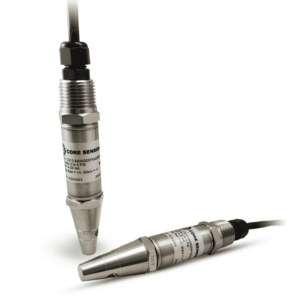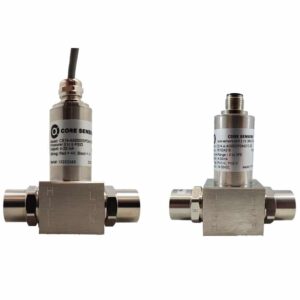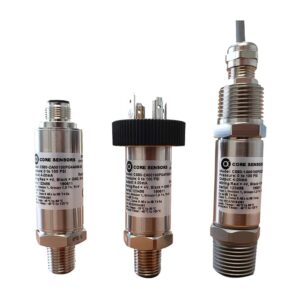Submersible – External – Differential

Liquid level sensors are a cost-effective solution for monitoring various types of liquids and are not negatively affected by foaming or reflection.
Liquid level sensors, also known as hydrostatic level sensors, measure level by converting the pressure of a liquid based on its height above the sensor and its density into a linear output signal. Liquid level sensors are a cost-effective solution for monitoring various types of liquids and are not negatively affected by foaming or reflection. Core Sensors has a solution for both industrial tank level applications and applications in Intrinsically Safe rated locations.
There are various installation methods that can be used when monitoring level with a pressure transducer:
Submersible
Vented Tank
The most common installation method is fully submerging and lowering a submersible designed sensor to the bottom of the tank or vessel that is being monitored. It is important to ensure that the sensor is at the very bottom of the tank to provide the most accurate level readings (see Figure 1). Submersible sensors are used in vented tanks and the sensor itself features a wide diameter vent tube that runs the length of the cable and terminates with the rest of the conductors. This vent tube allows the sensor to correct for any changes in barometric pressure which, in shorter tanks, is critical for ensuring accurate level readings. Core Sensors offers ETFE as a standard cable jacket material to ensure compatibility in a wide range of medias. Sensors come standard with a 1/2″ MNPT conduit fitting for customers that want to install conduit piping over the cable (see Figure 2). This method of installation is common in applications where the media may not be compatible with the jacket material or in mobile tanks. The conduit fitting will help keep the sensor stationary during tank movement. Core Sensors offers customisable submersible pressure transducers for both industrial and Intrinsically Safe applications.

Figure 1
Example: A Core Sensors submersible pressure transducer lowered to the bottom of the tank with the cable exiting the tank and terminating in a control box or other data acquisition system. The sensor will read its full scale output when the tank is full (or the full scale calibrated pressure of the sensor is reached) and will read its zero output when the tank is empty.

Figure 2
Example: A Core Sensors submersible pressure transducer lowered to the bottom of the tank with a rigid conduit pipe installed over the cable. The conduit pipe is connected to the top of the tank with a reducing tank fitting and the other side connected to the 1/2″ MNPT conduit on the sensor. The cable exits the tank and terminates in a control box or other data acquisition system. The sensor will read its full scale output when the tank is full (or the full scale calibrated pressure of the sensor is reached) and will read its zero output when the tank is empty.

Example: A Core Sensors pressure transducer externally threaded into a Tee fitting at the bottom of the tank with the cable terminating in a control box or other data acquisition system. The sensor will read its full scale output when the tank is full (or the full scale calibrated pressure of the sensor is reached) and will read its zero output when the tank is empty. This same installation method can be used with a differential pressure transducer.?
Externally Mounted
Vented Tank
Standard pressure transducers can be externally threaded into the side of the tank when using a submersible sensor is not ideal (see illustration below). Externally mounted sensors typically cost less than submersible sensors and there are less materials that need to be considered in terms of compatibility. These sensors are vented to atmospheric pressure through a vent tube or vent hole. Externally mounted sensors can be configured with integral cable as well as various connector options including an M12x1 Eurofast for an IP67 rating when used with an appropriate mating cable assembly.
Customers can also choose to install a submersible designed sensor externally with a 1/4″ NPT Male process connection instead of the standard nose cone. This installation method is ideal for environments where flooding is a concern such as ship compartments.
Differential pressure transducers can also be used to measure liquid level in a vented tank. The high side of the sensor, also referred to as P1, is threaded into the bottom of the tank while the low side, also referred to as P2, is left open to atmospheric pressure.

Example: A Core Sensors differential pressure transducer externally threaded into a fitting with the high side (P1) connected to the bottom of the tank and the low side (P2) connected to the top of the tank. The integral cable on the sensor is terminated in a control box or other data acquisition system. The sensor will read its full scale output when the tank is full (or the full scale calibrated differential pressure of the sensor is reached) and will read its zero output when the tank is empty (or the pressure differential across P1 and P2 is equal).
Externally mounted
Sealed Tank
When measuring liquid level in a tank that is completely sealed, it is ideal to use a differential pressure transducer to ensure accurate level measurements. The high side of the sensor, also referred to as P1, is threaded into the bottom of the tank while the low side, also referred to as P2, is threaded into the top of the tank (see illustration below). The sensor then measures the difference in pressure from the top to the bottom of the tank and transmits a linear output signal.
Selecting an output signal
Core Sensors offers various output signals for our liquid level monitoring products.
4-20mA is a popular output selection for applications where the output signal needs to be transmitted over a long distance without worrying about signal loss. This output signal requires a supply voltage of 10-28VDC. The current consumption is higher with a 4-20mA output signal than the other available outputs (20mA, typical).
1-5V is another popular output signal for level applications. This output signal requires a supply voltage of 10-28VDC and has a current consumption less than 10mA. 1-5V output is not recommended for long distance transmissions.
Low power voltage outputs including 0.5-4.5V Ratiometric and 0.5-2.5V Non-Ratiometric are available. These output signals are popular for monitoring in IOT applications and remote locations where energy conservation is top priority. The 0.5-4.5V Ratiometric output signal requires a regulated 5VDC supply and has a current consumption less than 5mA. The 0.5-2.5V Non-Ratiometric output signal requires 3-5VDC of unregulated power with less than or equal to 3mA current consumption.
Liquid level Sensors – submersible, external, differential | Core sensors. (2022, October 21).
https://core-sensors.com/liquidlevelsensors/



